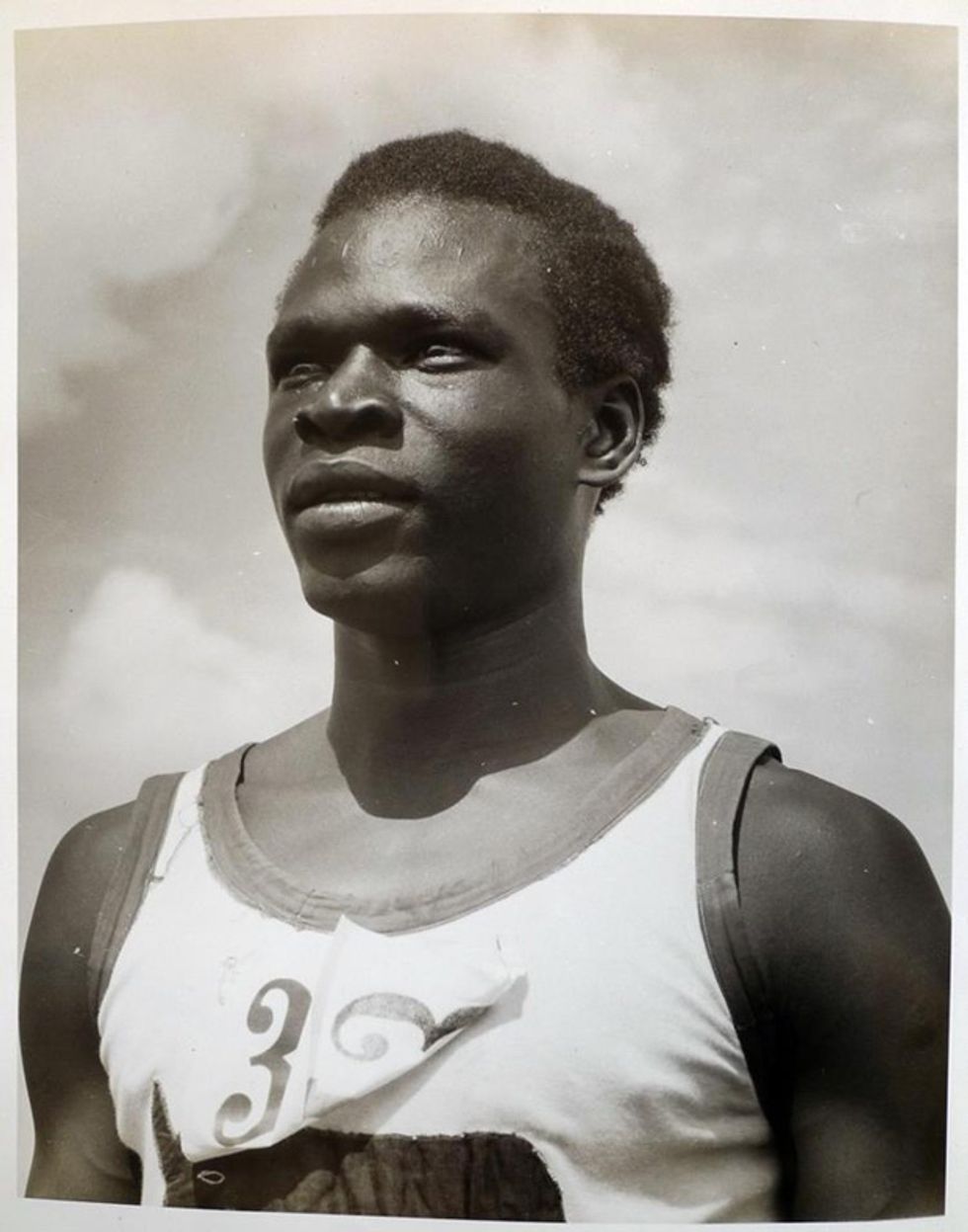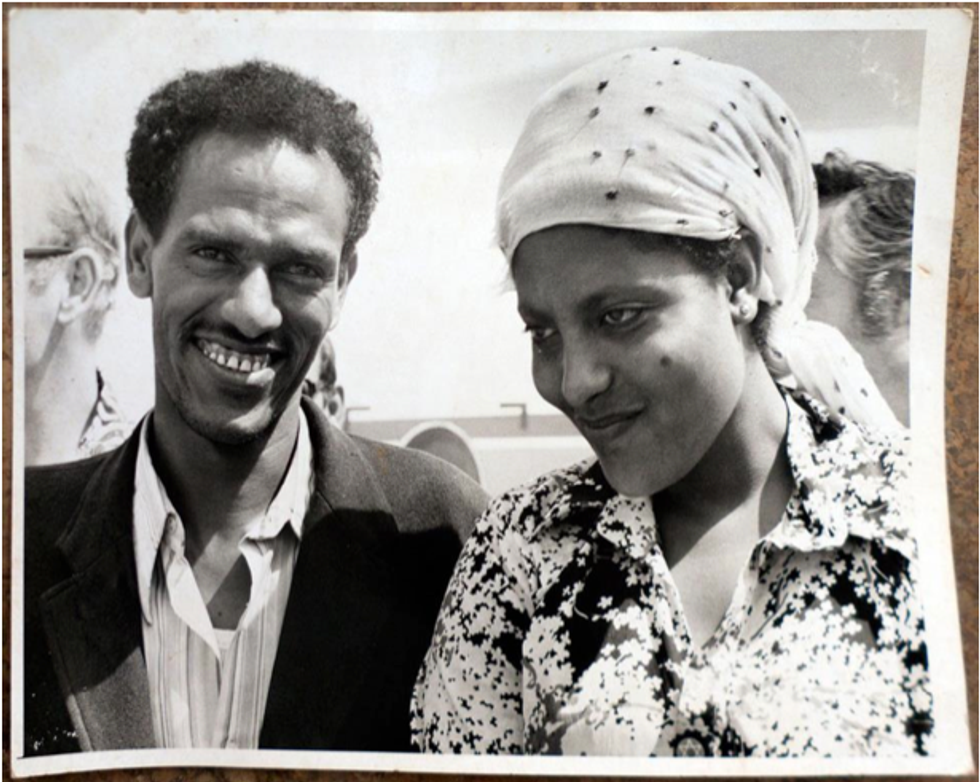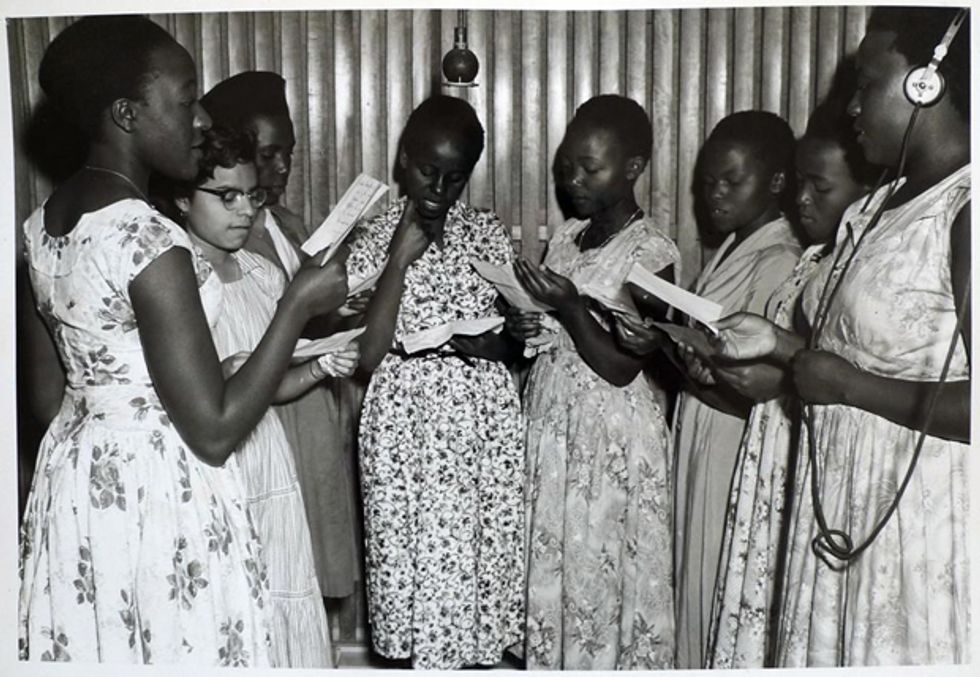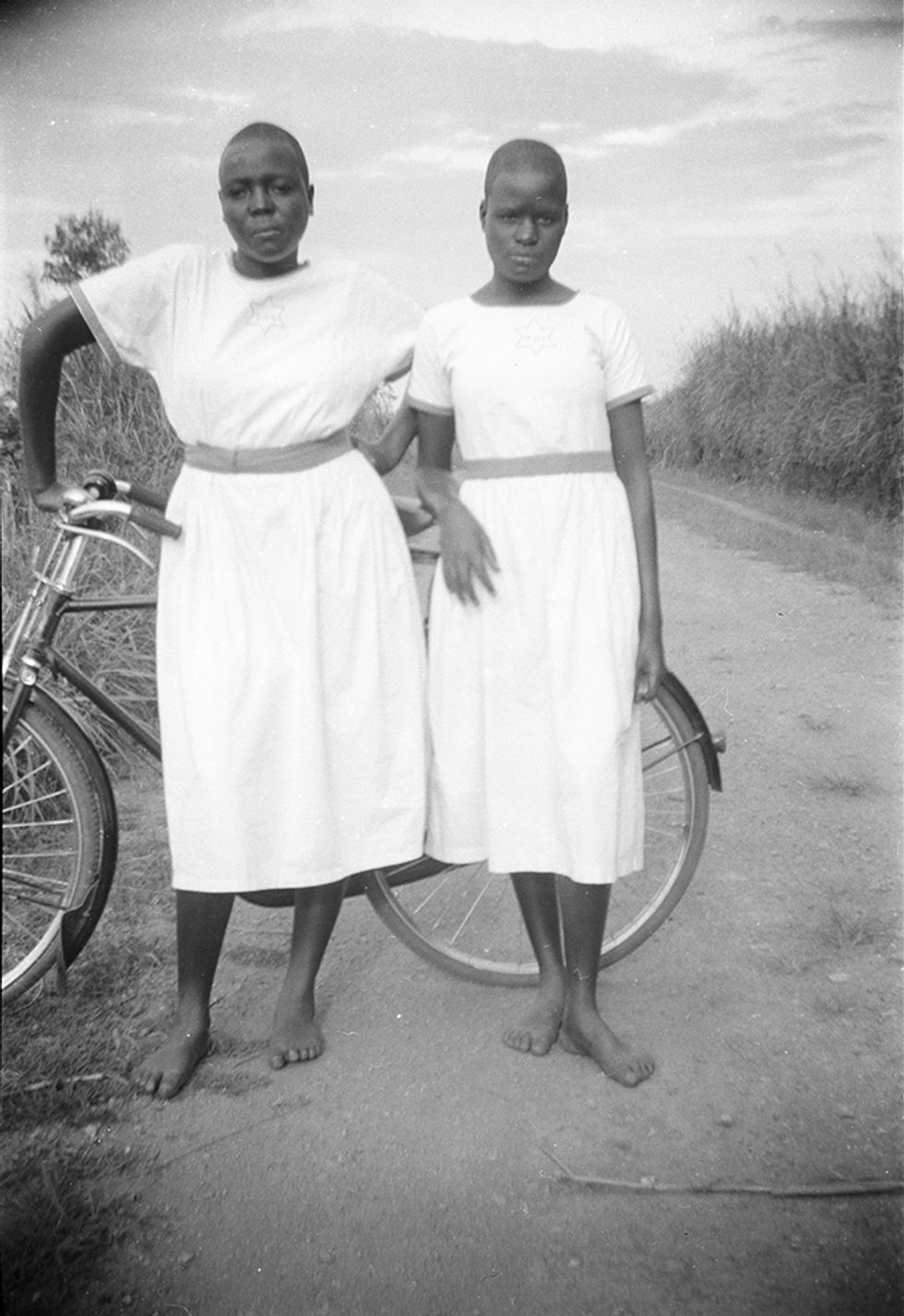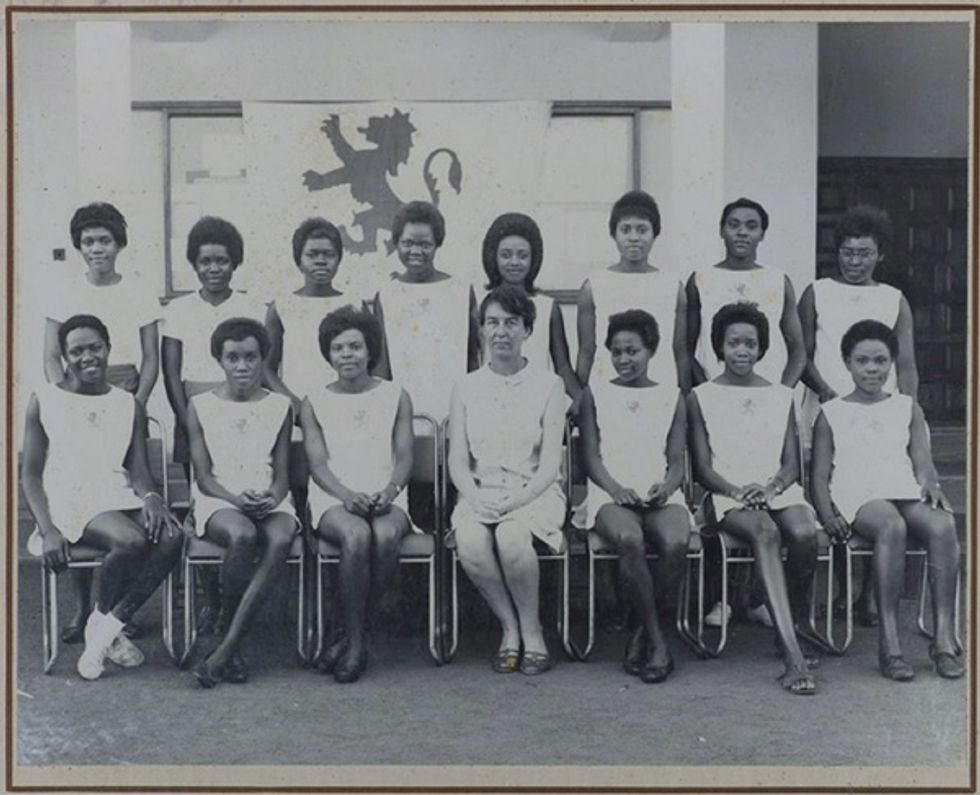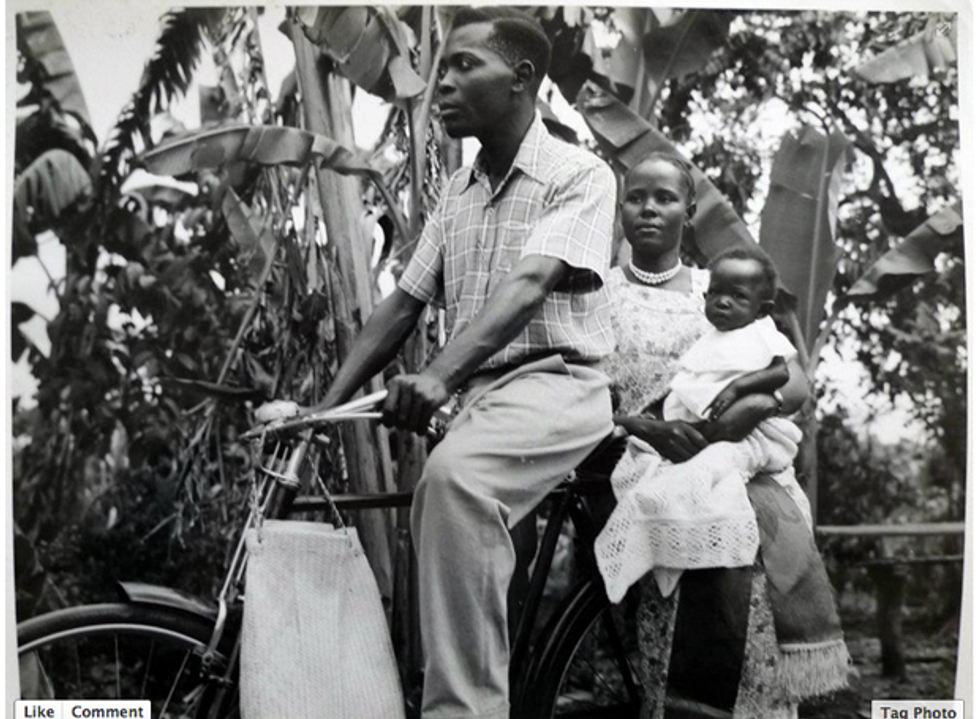Uganda's Unknown Vintage Photographs
Uganda's lost vintage photographs resurface on History in Progress, an online archive geared toward digging up unknown histories in East Africa.
History in Progress (HIP) is a well-curated time travel into Uganda's history. HIP was started in August 2011 by Rumanzi Canon, a Ugandan multi-media photographer, and Andrea Stultiens, a photographer from the Netherlands, with a mission to "create alternatives for the prevailing version(s) of the representation of (Ugandan) history by digitizing and sharing historic photographs." The photographs come from an array of mostly private archives are are staged primarily on HIP's active Facebook page. Facebook users tied to the photos are often surprised to see old images of their friends and family and are excited to share the narratives behind the photos in the comments section.
We recently caught up with Andrea Stultiens, who admitted that she's not comfortable describing herself as a photographer but rather someone "doing things with photographs." She says, "I make them, collect them, look at them, think and write about them. Sometimes I make the results of this visible for the rest of the world online, in books or in exhibitions." We asked her about the motivation, and background behind this project.
Posing to show off her mini dress. Photo by Kw Kaddu Wasswa.Uganda 1960's.
Kate Bomz for Okayafrica: Exactly how did History in Progress come about?
Andrea Stultiens: HIP started in August 2011. I had been working in Uganda for a couple of years on several photography projects. I have had a personal fascination with history as long as I can remember. After doing a photography exchange with children in Uganda and the Netherlands, I was curious to see photographs kept in Ugandan archives. Arthur Conrad Kisitu, who is a Kampala-based artist/photographer helped me to get access to the collection of Makerere University (the oldest university in East Africa), and then told me that his grandfather also had old photographs that might be of interest to me. This introduction led to a two year project, resulting in a traveling exhibition called The Kaddu Wasswa Archive at the Pitt Rivers Museum in Oxford (on display now until September of this year) and a book (available in its online version here).
When I was working on The Kaddu Wasswa Archive, I came across another collection of photographs. When I saw it, I was initially disappointed. The photographs were made by colonial administration and I felt they had a strong propaganda touch to them, showed an extremely one sided view of Uganda, and only rarely touched on the every day life documentation I was interested in. However, the person taking care of the photographs pointed out that it was important to add Ugandan perspectives to the colonial gaze. He was right of course, so I digitalized the photographs. Then they were just sitting on my hard disk, which also wouldn't give anyone the opportunity to add their perspective and information to what the photographs exhibit. So I started fantasizing about ways to share them. I didn't have any funding for it, so I knew it would have to be a low budget thing.
Information on the back of this photograph reads: Naume Lukungu. 1928-1931. Mengo Hosp. trained as a nurse. Worked at Busoga College Mwiri for 45yrs.Long service & given the honour of MBE 1961.Now retired at her country home at Nsube- Kamuli Rd. Jinja District.
Kate Bomz for OKA: How did you and your partner at HIP, Rumanzi Canon, meet?
AS: I met Rumanzi Canon at the exhibition of The Kaddu Wasswa Archive in Uganda. We started talking and he assisted me with some photography shoots I wanted to do in Kampala. It somehow, in a very organic way, happened that we started History In Progress Uganda together. We decided to put it on Facebook, since many Ugandans use that medium, and it's free. We also started a website, that ideally will one day function as a database. This is not yet the case though. Still on the things-to-do list.
Kate Bomz for OKA: What was initially your focus with HIP?
AS: The focus of HIP was, and still is, to make photographic records from (and about) Uganda available to a wide audience online and in other media (exhibitions and eventually possibly printed publications). The idea is that sharing information is crucial to nuance the, still limited and often one-sided, available version of Uganda’s recent history. The more views and ideas are added to the unfixed meaning of the photograph, the better. It still begins with my awareness of how little I understand combined with an interest in the photographic image, and has expanded into something that is potentially meaningful for all Ugandans interested in the history of their country and others that wish to see more of it than what the travel books and Invisible Children/Idi Amin movies have to offer.
To me HIP is now a way to learn, to share things I may not understand and images that I think are extremely beautiful and surprising. It is also a research tool to crowdsource information. Together we know more. I hope the archive is amusing to people, and will continue to give them the chance to add to what they know and I hope to add nuance to the history.
Kate Bomz for OKA: How did you manage to unearth these gems?
AS: Initially I browsed the internet. Quite a number of turn of the century books are digitized and are available for download. The British Library and the Library of Congress in Washington DC both have some amazing material they share online. So, I shared some of that, always crediting the original source as accurately as I could. And on top of that, Canon and I started approaching institutions and schools with a history. Asking them if they had an archive, and whether they would allow us to digitalize that. Then there was a snowball effect. Photographs posted occasionally either got recognized by people or maybe pointed us to other collections. Presently, I have not been able to follow up on all leads, but slowly and surely this will grow and happen.
At the moment, I am digitizing a collection of around 1500 negatives. They are from western Uganda, photographed by Musa Katuramu during a couple of decades, starting in the 1940s. The most recent find is always the most amazing, I guess.
Kate Bomz for OKA: My first experience with HIP was the amazing Bonnie and Clyde-esque story of the first plane hijacking in Africa by Mr Katsete and his wife (above), an Ethiopian couple. Again, how did you stumble upon that?
AS: Well, the photographs were in a small but still interesting collection of images held in the Uganda National Archives in Entebbe. They were a strange lot, the couple didn't look distinctly Ugandan, the photographs had a touch of stardom to them, they even reminded me of fashion photography. I had no idea what the story behind them could entail. Then someone pointed me to the recent publication by Fountain Publishers of articles on Uganda in Drum Magazine. There, I found the story and linked it with the photographs from the archive.
Excerpt from Drum Magazine June 1974
It took Africa by surprise - the first case of air piracy of its kind over African soil. An Ethiopian couple seeking refuge because of the political situation in their country attempted to reach Libya by hijacking an East African Airways plane to take them first to Libya and then to Moskow. Uganda's President Amin personally intervened to put a prompt end to the drama when he persuaded the Ethiopians to surrender at Entebbe Airport, Kampala.
The two Ethiopians, armed with a pistol, had seized an East African Airways Fokker Friendship F27 on its way from Nairobi to Malindi. Holding the crew at gunpoint, they ordered the pilot to change course and fly to Libya, "or be shot". The aircraft was carrying 31 passengers, most of them tourists, and four crew. Captain Penfold changed course and put down at Entebbe it was believed to refill.
The airline appealed to the Ugandan authorities not to intervene hastily. But when he heard of the hijack, President Amin clashed to the airport and was waiting there when the plane landed. Ugandan troops ringed the aircraft. General Amin made a successful appeal to the two Ethiopians, and the passengers, all fit and well, were released.
Photo taken from the Uganda Protectorate Public Relations Department.
Kate Bomz for OKA: What has been the initial feedback and attitude toward HIP? What's your five year trajectory?
AS: So far most feedback from individuals from Uganda has been very positive. Some people think it's a boring venture. I guess for some the focus is too much on the everyday life and not enough on the big stories already (partly) known. Sometimes I get signals that someone thinks it's strange and not right that an outsider is doing this. But I believe in my motives and try to work them out as openly as possible, trying to credit everyone helping and involved. I can't do this without the cooperation of everyone (and that is mainly Ugandans) making their material available, and also believing that sharing is important.
I hope it will continue to grow. I try to keep it small for now not to shut people out, but to make sure I can keep up with a certain quality standard in the reproduction of the photographs and the way they are shared. Ideally down the line more people would get involved, it's very cumbersome for one person. Also being very aware, I am not Ugandan, I will therefore forever have a limited understanding of what I see, as it is I don’t currently reside in Uganda, even though I try to be there as often as I can.
At the moment myself and Richard Vokes, an anthropologist whose been working in Uganda for over 10 years, are trying to get funding to digitize specific collections up to academic standards and more actively contextualize the material. The already mentioned website/database, making the collection browsable and useable as a research database for people interested in specific topics is also high on the list. I hope and expect that this will be up, running and growing in 5 years.
1. Mock Jazz Band. Ca. 1960. From 'The Kaddu Wasswa Archive'.
We asked Andrea to share her favorite images. Her 3 selections are of photographs scanned from negatives taken by Ugandan Photographers.
Andrea on Mock Jazz Band: This photograph reminds me of some of images made by the famous photographer from Mali, Malick Sidibé. I don't know how it was made but i know why it was made. Kaddu Wasswa shared and collected magazines from British friends in the late 1950s and early 1960s and distributed them among the girls in his Youth Groups Club. In one of them there was a drawing of a jazz band. Kaddu and his friends loved it, and starting acting out this mock jazz band, with a double bass that is not really functional. Look at the fun they are having! Here is the link to Facebook album.
2. Deo Kyakulagira, self portrait in his dark room. Ca. 1970.
Andrea on Deo Kyakulagrira's self-portrait: I was introduced to Deo Kyakulagira (1940-2000) and his work through his son Denis Kalyango. Denis saw the exhibition of the Kaddu Wasswa Archive and asked me whether I would be interested in working on something similar with his father's legacy. I was interested and have been working with the family ever since. Deo was a photographer who operated his own studio. He also worked for the ministry of agriculture in Entebbe, and the department of medical illustration of Mulago hospital in Kampala. Denis tells me his father Deo was like the pianist in Roman Polanski's film. He was saved by his profession several times. Deo made amazing self portraits in the various darkrooms he worked in. Very unusual. I have never seen something like it before. This is my favorite one of that set. Probably because of the light and his gesture.
Here is a link to the Facebook album, it's still a work in progress.
3. Musa Katuramu, Two Girls With Bicycle. 1940s
Andrea on Two Girls With Bicycle: This image is one example from the Musa Katuramu collection I have been working on for the last couple of months. I could have picked many other photographs from the collection for their individual charm, but they are so extremely significant because of their quantity. Reason being; they are made by one man -Musa Katuramu- photographing his community in Western Uganda for a couple of decades starting around 1940. This is just a little sneak preview into an extremely special collection of (mainly) portraits, made by a Ugandan photographer during a time when almost all photographic imagery in Uganda was made by missionaries, colonials or the photo studios that were almost exclusively owned by Indians.
Many of HIP's images are posted without a story, however, context, identity, and histories are crowdsourced through Facebook. The photo above is from the collection of the Ham Mukasa Family and was taken at the Kings College in Uganda. This picture has appeal because you can see individuality that shined thru the hairstyles eventhough all the girls were in uniform. With further research we learned that Kings College predates Makerere University as one of the first centers of Higher learning in Uganda founded in 1906, and that famous Ugandan poet, Okot p'Bitek, is an alum. See below how the Facebook community reflects on the people they recognize as well as aspects of the school.
After History in Progress posted the above photo on Facebook, a user called Mary Joy Wandera was able to identify the adults as Ben and Anna Kiyimba. Another piece of the puzzle solved.
Andrea: Through posting this image on Facebook, we got in touch with the Ham Mukasa Foundation (Kings college collection), whose collection is already digitized, this an archive we are trying to find funding for to do a more academic survey on.
I have to mention that this photograph was taken in the studio of Deo Kyakulagira (The photographer with a self portrait). Deo's son, Denis recognized the props and background.
History in Progress on Facebook
See "The Kaddu Wasswa Archive" at the Pitts River Museum in Oxford, England now through September 2013. Details here.
- Photos: #AfricanVintageLove Is a Celebration of the Couples In Our ... ›
- Spotlight: Artist, Ngadi Smart, Captures Black Sensuality, Sexuality ... ›
- 100 Women: Malin Fezehai Is the Renowned Photographer Helping ... ›
- These Photographers From Africa and Its Diaspora Expose the ... ›
- Black Social Photography in South Africa: Before & After - OkayAfrica ›
- Opinion: The MTV MAMAs Shouldn't Be Happening in Uganda - OkayAfrica ›
- Akon In Uganda, the Laundering of a Dictatorship - OkayAfrica ›
- Usher Komugisha BAL female commentator - OkayAfrica ›
- Sungi Mlengeya Uses Her Art to Celebrate Tanzanian and Ugandan Women - OkayAfrica ›
- The Vintage Ugandan Photography Of Musa Katuramu - Okayplayer ›
- Photos: James Barnor 'Ever Young' - Okayplayer ›
